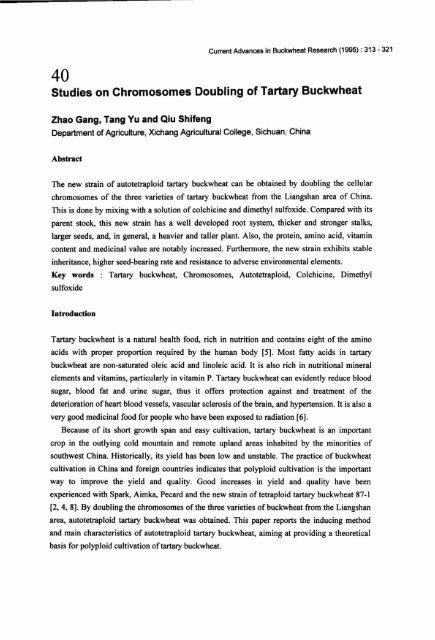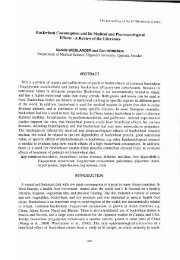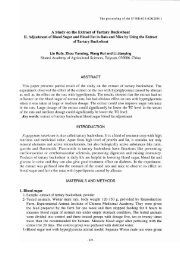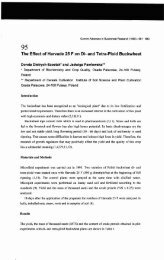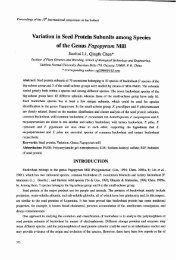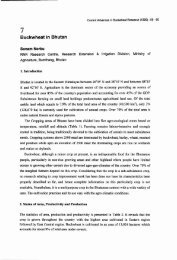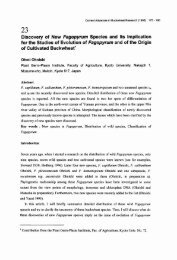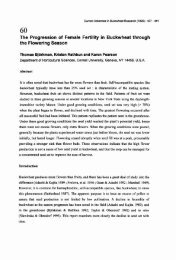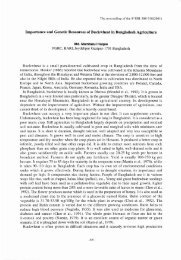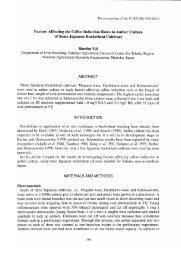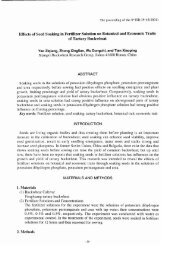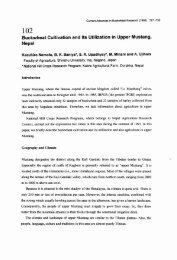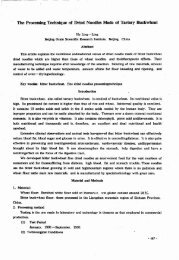40. Studies on Chromosomes Doubling of Tartary Buckwheat
40. Studies on Chromosomes Doubling of Tartary Buckwheat
40. Studies on Chromosomes Doubling of Tartary Buckwheat
You also want an ePaper? Increase the reach of your titles
YUMPU automatically turns print PDFs into web optimized ePapers that Google loves.
Current Advances in <strong>Buckwheat</strong> Research (1995) : 313 - 321<br />
40<br />
<str<strong>on</strong>g>Studies</str<strong>on</strong>g> <strong>on</strong> <strong>Chromosomes</strong> <strong>Doubling</strong> <strong>of</strong> <strong>Tartary</strong> <strong>Buckwheat</strong><br />
Zhao Gang, Tang Yu and Qiu Shifeng<br />
Department <strong>of</strong> Agriculture, Xichang Agricultural College, Sichuan, China<br />
Abstract<br />
The new strain <strong>of</strong> autotetraploid tartary buckwheat can be obtained by doubling the cellular<br />
chromosomes <strong>of</strong> the three varieties <strong>of</strong> tartary buckwheat from the Liangshan area <strong>of</strong> China.<br />
This is d<strong>on</strong>e by mixing with a soluti<strong>on</strong> <strong>of</strong>colchicine and dimethyl sulfoxide. Compared with its<br />
parent stock, this new strain has a well developed root system, thicker and str<strong>on</strong>ger stalks,<br />
larger seeds, and, in general, a heavier and taller plant. Also, the protein, amino acid, vitamin<br />
c<strong>on</strong>tent and medicinal value are notably increased. Furthermore, the new strain exhibits stable<br />
inheritance, higher seed-bearing rate and resistance to adverse envir<strong>on</strong>mental elements.<br />
Key words : <strong>Tartary</strong> buckwheat, <strong>Chromosomes</strong>, Autotetraploid, Colchicine, Dimethyl<br />
sulfoxide<br />
Introducti<strong>on</strong><br />
<strong>Tartary</strong> buckwheat is a natural health food, rich in nutriti<strong>on</strong> and c<strong>on</strong>tains eight <strong>of</strong> the amino<br />
acids with proper proporti<strong>on</strong> required by the human body [5]. Most fatty acids in tartary<br />
buckwheat are n<strong>on</strong>-saturated oleic acid and linoleic acid. It is also rich in nutriti<strong>on</strong>al mineral<br />
elements and vitamins, particularly in vitamin P. <strong>Tartary</strong> buckwheat can evidently reduce blood<br />
sugar, blood fat and urine sugar, thus it <strong>of</strong>fers protecti<strong>on</strong> against and treatment <strong>of</strong> the<br />
deteriorati<strong>on</strong> <strong>of</strong>heart blood vessels, vascular sclerosis <strong>of</strong>the brain, and hypertensi<strong>on</strong>. It is also a<br />
very good medicinal food for people who have been exposed to radiati<strong>on</strong> [6].<br />
Because <strong>of</strong> its short growth span and easy cultivati<strong>on</strong>, tartary buckwheat is an important<br />
crop in the outlying cold mountain and remote upland areas inhabited by the minorities <strong>of</strong><br />
southwest China. Historically, its yield has been low and unstable. The practice <strong>of</strong> buckwheat<br />
cultivati<strong>on</strong> in China and foreign countries indicates that polyploid cultivati<strong>on</strong>'is the important<br />
way to improve the yield and quality. Good increases in yield and quality have been<br />
experienced with Spark, Aimka, Pecard and the new strain <strong>of</strong> tetraploid tartary buckwheat 87-1<br />
[2,4,8]. By doubling the chromosomes <strong>of</strong>the three varieties <strong>of</strong>buckwheat from the Liangshan<br />
area, autotetraploid tartary buckwheat was obtained. This paper reports the inducing method<br />
and main characteristics <strong>of</strong> autotetraploid tartary buckwheat, aiming at providing a theoretical<br />
basis for polyploid cultivati<strong>on</strong> <strong>of</strong>tartary buckwheat.
314<br />
Materials and Methods<br />
In the spring <strong>of</strong> 1989, the three varieties <strong>of</strong>tartary buckwheat, namely, Eluowuqie, Shichee and<br />
Kuciqiao were cultivated in pots at the Agricultural Test Stati<strong>on</strong> <strong>of</strong> Xichang Agricultural<br />
College. Forty pots were planted for each variety. After the seeds sprouted, four plants were<br />
kept in each pot. The following method <strong>of</strong> treatment for the doubling <strong>of</strong> the chromosomes <strong>of</strong><br />
Jiujiang tartary buckwheat was used [9, 10]. After 2-3 leaves appeared, absorbent cott<strong>on</strong> balls<br />
were placed <strong>on</strong> the growing point <strong>of</strong> the leafstalk. A soluti<strong>on</strong> mixture <strong>of</strong> colchicine (0.2%) and<br />
dimethyl sulfoxide (1.5%) was dropped <strong>on</strong> the growing point. This was d<strong>on</strong>e twice a day (<strong>on</strong>e<br />
in the morning and the other in the evening) for six days.<br />
The following tasks were completed : the botanical characteristics were identified and the<br />
number <strong>of</strong>chromosomes <strong>of</strong>the root tip cells were examined and counted. After the seeds <strong>of</strong> the<br />
above menti<strong>on</strong>ed plants were obtained and treated, they were sowed in the Autumn <strong>of</strong>the same<br />
year. Good plants were selected when ripe. Each variety <strong>of</strong>seed was sowed and harvested at the<br />
same times.<br />
In 1990, the seeds <strong>of</strong> the three varieties <strong>of</strong> autotetraploid tartary buckwheat and its diploid<br />
parent stock were respectively sowed in large fields in holes 35 cm apart. After sprouting, four<br />
plants were retained in each hole. During the seedling stage the peroxidase isozymes <strong>of</strong> their<br />
leaves were electrophoreticly analyzed and stained with benzidine diaminodiphenyl.<br />
Photographs were taken immediately [11]. The following tasks were completed: the botanical<br />
characteristics were identified and recorded ; leaf guard cells, pollen grains and the sizes <strong>of</strong><br />
their root tip mitotic cells were examined, and measured during flowering period. The seeds<br />
were dried when they were ripe and the amounts <strong>of</strong> amino acids in the seeds <strong>of</strong> both the<br />
autotetraploid tartary buckwheat and its parent stock were measured with a Hitachi 835-50<br />
High Rate Amino Acid Analyzer. The amounts <strong>of</strong> nutrients-crude proteins, fats, starches and<br />
vitamins-were also measured according to the related methods <strong>of</strong>the Internati<strong>on</strong>al Associati<strong>on</strong><br />
<strong>of</strong>Seed Testing.<br />
Results and Analyses<br />
1. The Effect <strong>of</strong>Treatment by the Soluti<strong>on</strong> Mixture <strong>of</strong>Colchicine and Dimentyl Sulfoxide<br />
Am<strong>on</strong>g the treated plants, some died <strong>of</strong>pois<strong>on</strong>ing. In the surviving plants the variety SHICHEE<br />
proved to be the most successful. It's doubling percentage was 62.81%, and the effect <strong>of</strong> the<br />
treatment was also the best being 47.50. However, the doubling percentage and treatment effect<br />
<strong>of</strong>the variety KUCHIQIAO were relatively poor (see Table 1).<br />
The growing point <strong>on</strong> the main stalk <strong>of</strong>the successfully doubled plant expanded and stopped<br />
growing taller. 7-12 days after being treated, 2-5 shoots grew from the swollen knot and the<br />
plant appeared to be mosaic. Some shoots were creepers, and grew many wild roots from the<br />
knot. The plant was shorter, leaves became thicker, leaf colour became deeper and there was a<br />
marked change in the shape <strong>of</strong> the leaves. There were two types <strong>of</strong> flower <strong>on</strong> the plant. The<br />
diameter <strong>of</strong>the corolla <strong>on</strong> <strong>on</strong>e flower being larger than the other, and the resulting seeds being<br />
larger from the larger flower. The small seeds from the small flower <strong>on</strong> the mosaic were similar
315<br />
to the seeds from 'the parent stock (c<strong>on</strong>trast) (see Table 2). After eXaminati<strong>on</strong> 'under a<br />
microscope, it was found that the number <strong>of</strong> chromosomes in the root tip cell <strong>of</strong>the'largerseed<br />
was 2n = 4x = 32. It was autotetraploid. The number <strong>of</strong>chromosomes in. the root tip cell <strong>of</strong>the<br />
small seed <strong>on</strong> both the parent stock and the mosaic was 2n = 2x = 16. They were diploids (see<br />
Picture I, II)<br />
Table I. Survival rate and chromosomes-doubling <strong>of</strong>different plants.<br />
Variety Treated No. Survived No. Dead No, Successfully- <strong>Doubling</strong>-Rate Treatment Effect<br />
Doubled No.<br />
Eluowuqie 160 107 23 64 59.81 -<str<strong>on</strong>g>40.</str<strong>on</strong>g>00<br />
Shichee 160 121 29 76 62.81 47.50<br />
Kuochiqiao 160 110 34 61 55.45 38.13<br />
Note: Any plant from which more than <strong>on</strong>e doubled seed was harvested means that the plant was successfully doubled.<br />
<strong>Doubling</strong> Rate = Successfully doubled No. I Survived No,<br />
Treatment Effect =Successfully doubled No, I Treated No,<br />
Table 2. A comparis<strong>on</strong> <strong>on</strong> flower and seed between doubled plants and CK plants.<br />
Variety Corolla Dia. (mm) Seed L.x W. (mm),<br />
Eluowuqie diploid (CK) 3.29 5.2 x 3.7<br />
Eluowuqie mosaic 2x 3.27 5.4 x 3.6<br />
4x 4.41 6.9 x4,9<br />
Shichee diploid (CK) 3.38 5.8 x 3.2<br />
Shichee mosaic 2x 3.34 5.7 x 3.0<br />
4x 4.75 7.9 x 3.6<br />
Kuciquiao diploid (CK) 3.16 5.0 x 4.7<br />
Kuciquiao mosaic 2x 3.17 4.8 x 4.6<br />
4x 4.59 7.1 x 5.9<br />
2. Main Characteristics <strong>of</strong>the Tetraploid <strong>Tartary</strong> <strong>Buckwheat</strong><br />
Compared with the diploid parent stock (CK), the tetraploid has a taller plant, thicker stalk,<br />
many shoots <strong>on</strong> the main stalk. less leaves but larger in size. The seed-forming rates <strong>of</strong> aU the<br />
tetraploid tartary buckwheat are decreased. The average seed-f<strong>on</strong>ning rate <strong>of</strong> Eluowuqie<br />
tetraploid is 24.12%, 16.05% less than the c<strong>on</strong>trast rate 28.73%. The average seed-f<strong>on</strong>ni!1g rate<br />
<strong>of</strong> Shichee tetraploid is 27.1%, 10.56% less than the c<strong>on</strong>trast rate. However, what merits<br />
attenti<strong>on</strong>. is that, because <strong>of</strong> the smaller fJowers <strong>of</strong> the single plant <strong>of</strong> tetraplo.id tartary<br />
buckwheat being notably increased (about 30-50%), its seeds from a single plant are still more<br />
than that from diploid parent stock. In additi<strong>on</strong>, the se~ds <strong>of</strong> tetraploid' tartary buckwheat are<br />
remarkably enlarged. Thus the yield <strong>of</strong>a single plant is higher than that <strong>of</strong> diploid tartary<br />
buckwheat (see Table 3).
316<br />
Table 3. A comparis<strong>on</strong> between the botanical characteristics <strong>of</strong>tetraploid tartary buckwheat<br />
and diploid tartary buckwheat.<br />
Plant<br />
Stem<br />
Seed-<br />
Height Diameter Shoots Leaves <strong>of</strong> LeafArea No. <strong>of</strong> Weight <strong>of</strong> f<strong>on</strong>ning<br />
Varietry (cm) (mm) No. a Plant (cm 2 ) Seeds Seeds rate<br />
Eluowuqie 4X 84.3 6.8 5.1 101.3 1406.7 261.3 7.86 24.12<br />
Eluowuqie 2X 71.7 4.2 3.9 120.7 1027.4 247.5 4.83 28.73<br />
Shichee4X 67.5 5.9 4.7 89.5 1250.3 1250.3 307.1 27.10<br />
Shichee2X 61.3 3.7 3.6 112.3 998.5 264.5 4.95 30.30<br />
Kuciqiao4X 78.2 6.4 6.6 97.4 1320.8 175.5 5.15 23.16<br />
Kuciqiao2X 70.1 4.7 4.1 127.1 1104.3 164.5 3.31 28.43<br />
For instance, the average seeds from a plant <strong>of</strong> Shichee tetraploid is 307.1, which is 42.6<br />
more than the c<strong>on</strong>trast (264.5). The average weight <strong>of</strong>the seeds <strong>of</strong> Shichee tetraploid is 8.41 g,<br />
which is 3.46 g heavier than the c<strong>on</strong>trast (4.95 g). Microscopic examinati<strong>on</strong> shows that the leaf<br />
guard cells, pollen grains and the root tip mitotic cells <strong>of</strong> tetraploid tartary buckwheat are<br />
obviously larger than those <strong>of</strong>diploid parent stock (see Table 4).<br />
Table 4. A comparis<strong>on</strong> between cells <strong>of</strong>tetraploid and diploid tatrary buckwheat (UM) .<br />
Root Tip Mitotic Cells<br />
Pollen<br />
LeafGuard Cells Cell Nucleus Cell<br />
Variety L % W % Dia. % Dia. % Dia. %<br />
Eluowuqie 4X 36.4 130.47 24.7 122.89 41.1 155.7 19.0 125.0 47.2 156.8<br />
Eluowuqie 2X 27.9 100 20.1 100 26.4 100 15.2 100 30.1 100<br />
Sbicbee4X 38.1 125.74 27.3 129.4 39.9 159.0 17.8 119.5 45.3 139.8<br />
Sbicbee 2X 30.3 100 21.1 100 21.1 100 14.9 100 32.4 100<br />
Note: Data in the table are the mean values <strong>of</strong> 100 cells.<br />
3. Electrophoretic Analysis <strong>on</strong> Peroxidase Isozyme <strong>of</strong> Leaves <strong>of</strong> Tetraploid <strong>Tartary</strong><br />
<strong>Buckwheat</strong><br />
After electrophoretic analyses <strong>on</strong> the peroxidase isozyme <strong>of</strong> leaves being d<strong>on</strong>e during the<br />
seedling stage, it is found that there are some differences between both zymobelt and zymeactivity<br />
<strong>of</strong> tetraploid and diploid tartary buckwheat. For instance, in the belt with RF value <strong>of</strong><br />
0.85, the three varieties <strong>of</strong> tetraploid tartary buckwheat appear to be weak belt, but the three<br />
varieties <strong>of</strong> diploids are all mid-str<strong>on</strong>g belt. Numbers <strong>of</strong> all varieties <strong>of</strong> tetraploid tartary<br />
buckwheat are respectively less than those <strong>of</strong> diploid tartary buckwheat (CK). For example, the<br />
Eluowuqie tetraploid has 6 zymobelts while its diploid has 8 zymobelts (see Table 5).
317<br />
Table 5. RF value and zyme-activity <strong>of</strong>peroxidase isozyme <strong>of</strong>tetraploid <strong>Tartary</strong> buckwheat.<br />
RfValue<br />
Variety 0.33 0.42 0.55 0.58 0.61 0.81 0.85 0.87<br />
Eluowuqie 4X ++ ++ +++ + + ++<br />
Eluowuqie 2X ++ ++ +++ ++ ++ + ++ +<br />
Shichee4X ++ ++ +++ + + +<br />
Shichee 2X ++ ++ +++ ++ + + ++ +<br />
Kuciqiao 4X ++ ++ +++ + ++<br />
Kuciqiao 2X ++ ++ +++ ++ + + + +<br />
Note: +++ = str<strong>on</strong>g belt; ++ = mid-str<strong>on</strong>g belt; + = weak belt.<br />
It is thus clear that the transcripti<strong>on</strong> RNA <strong>of</strong> tetraploid tartray buckwheat was changed<br />
because <strong>of</strong>the increase <strong>of</strong> gene dosage, and there were differences both in variety and quantity<br />
compared with the diploid tartray buckwheat.<br />
4. Quality <strong>of</strong>Tetraploid <strong>Tartary</strong> <strong>Buckwheat</strong><br />
It is found, after laboratory tests, that the protein, fat and vitamins c<strong>on</strong>tent <strong>of</strong> the tetraploid<br />
tartary buckwheat are all higher than those <strong>of</strong>the diploid, especially vitamin P which increases<br />
c<strong>on</strong>siderably. Except methi<strong>on</strong>ine, all other amino acids in the tetraploid buckwheat which are<br />
needed by the human body are higher than those <strong>of</strong>diploid tartary buckwheat (see Table 6).<br />
Table 6. A comparis<strong>on</strong> between main nutrients <strong>of</strong>tetraploid and diploid tatary buckwheat.<br />
Variety E.4X E.2X S.4X S.2X K.4X K. 2X<br />
Crude Protein (%) 14.1 11.7 3.5 10.9 14.5 11.1<br />
Crude Fat (%) 3.11 2.47 3.05 2.64 2.91 2.38<br />
Vit. Bl (mg / g) 0.21 0.17 0.19 0.16 0.23 0.17<br />
Vit. B2 (mg / g) 0.49 0.44 0.51 0.47 0.53 0.46<br />
Vit. P(%) 4.17 2.99 4.43 3.16 4.26 3.04<br />
Thr. (%) 0.54 0.36 0.50 0.33 0.57 0.39<br />
Val. (%) 0.61 0.60 0.57 0.43 0.59 0.57<br />
Met. (%) 0.05 0.06 0.04 0.05 0.03 0.03<br />
Leu. (%) 1.01 0.74 0.95 0.63 1.17 0.81<br />
lie. (%) 0.59 0.43 0.47 0.39 0.60 0.41<br />
Try. (%) 0.17 0.14 0.15 0.10 0.19 0.11<br />
Phe. (%) 0.65 0.50 0.57 0.43 0.69 0.47<br />
Lys. (%) 0.87 0.61 0.74 0.53 0.83 0.44<br />
Note: E. = Eluowuqie ; S. - Shichee ; K. =Kuciqiao.
318<br />
C<strong>on</strong>clusioD<br />
1. lJp. to now,. colchicine is still <strong>on</strong>e <strong>of</strong> the 'best agents uS.ed for d.oublingchromosQmes. <strong>of</strong><br />
buckwheat. Previous experiments indicate that the best diluti<strong>on</strong> is 0.2% if colchicine<br />
soluti<strong>on</strong> <strong>on</strong>ly is used to treat buckwheat seedlings. The successful doubling-rate is 3'0-40%<br />
when this kind <strong>of</strong> soluti<strong>on</strong> is used to treat Jiangxi Jiuijiang tartary buckwheat [9], and 20<br />
35% for comm<strong>on</strong> buckwheat [2]. Tests in this paper were c<strong>on</strong>ducted by using the mixed<br />
soluti<strong>on</strong> <strong>of</strong>colchicine and dimethyl sulfoxide to treat the three varieties <strong>of</strong>tartary buckwheat,<br />
and a better effect is achieved. The successful doubling-rate reaches 55-65%. This shows<br />
that dimethyl sulfoxide can accelerate colchicine penetrating the cells <strong>of</strong> the plant quickly,<br />
shortening the treatment time, and improving the effect <strong>of</strong>the treatment. This corresp<strong>on</strong>ds to<br />
Bai Shouxin's result [1].<br />
2. The tetraploid tartary buckwheat has a well developed root system, thicker and str<strong>on</strong>ger stalk,<br />
and wider leaves. Its flowerets and seeds are notably increased, and the seeds are much<br />
enlarged. It is probable that this good relati<strong>on</strong>ship <strong>of</strong> co-ordinati<strong>on</strong> and balance am<strong>on</strong>g<br />
source, flow and storage is <strong>on</strong>e <strong>of</strong>the reas<strong>on</strong>s that tetraploid tartary buckwheat has a higher<br />
plant productivity than diploids.<br />
3. The tetraploid tartary buckwheat has stable inheritance. The microscopic examinati<strong>on</strong>s for<br />
three generati<strong>on</strong>s c<strong>on</strong>tinued to exhibit normal gametes (n = 2x = 16) when the sexual cells<br />
divide. The differences in the peroxidase isozymes <strong>of</strong> leaves between tetraploid and diploid<br />
tartary buckwheats explains that the gene expressi<strong>on</strong>s <strong>of</strong> these two varieties <strong>of</strong> buckwheat<br />
are not exactly the same. Most autotetraploid plants can not inherit stably. However, Mr.<br />
Yian Yurui and Mr. Zhang Zha<strong>on</strong>an recently have achieved very good results <strong>on</strong> studies <strong>on</strong><br />
tetraploid rice and tetraploid barley [2, 12]. This clearly shows that it is still effective to<br />
induce autopolyploid into cultivated crops.<br />
4. TetrapJoid tartary buckwheat has superior characteristics. Its protein, fat, vitamins as well as<br />
amino acid c<strong>on</strong>tent are all higher than those <strong>of</strong>diploid tartary buckwheat, in which vitamin P<br />
increases the most. Therefore, it is quite evident that tetraploid tartary buckwheat is <strong>on</strong>e<br />
variety <strong>of</strong> health food which is high in quality and rich in nutriti<strong>on</strong>. It is worthy <strong>of</strong> further<br />
study and development.
31.9<br />
•••<br />
-.'<br />
••••<br />
...<br />
• •<br />
2<br />
•<br />
•<br />
• •<br />
• • •<br />
4<br />
. ,<br />
.. .<br />
.- ,<br />
,•<br />
·~ ,<br />
1/1<br />
I .. ..<br />
•<br />
• • •<br />
6<br />
• • •<br />
•<br />
.- ••• •<br />
•<br />
• 4<br />
• •<br />
Picture I<br />
1. Seeds <strong>of</strong>Eluowuqie Tetraploi<br />
2. Seeds <strong>of</strong>Eluowuqie Diploid<br />
3. Seeds <strong>of</strong>Shichee Tetraploid<br />
4. Seeds <strong>of</strong>Shichee Diploid<br />
5. Seeds <strong>of</strong>Kuciqiao Tetraploid<br />
6. Seeds <strong>of</strong>Kuciqiao Diploid
320<br />
I 1 , 2<br />
I<br />
I<br />
• •<br />
,<br />
~<br />
•<br />
• I<br />
• • •<br />
,~.<br />
•<br />
•<br />
c , ,<br />
• .. , , •<br />
• , #<br />
•<br />
• ~ ~<br />
, •<br />
• • r •<br />
•<br />
• •<br />
• • •<br />
I<br />
3 ,<br />
..<br />
4<br />
,.<br />
•<br />
- - •<br />
•<br />
.. , ,.<br />
1<br />
,.<br />
~<br />
..<br />
fill<br />
•<br />
• f<br />
f •<br />
I r •<br />
,<br />
321<br />
References<br />
(1) Bai Shouxin. A Study <strong>on</strong> Redoubling <strong>Chromosomes</strong> <strong>of</strong> Haploid Wheat. Newspaper <strong>of</strong><br />
Genetics. 1979,6 (2): 210-232.<br />
(2) Chen Zhiy<strong>on</strong>g. Recent Development <strong>on</strong> Autotetrap10id Rice. China Agricultural Science.<br />
1987, 20 (1) : 20-24.<br />
(3) E. C. Alikshiyevoi (Translated by Li Ke1ai). Inheriting Breeding and Good Strains Breeding<br />
<strong>of</strong><strong>Buckwheat</strong>. The Agriculture Publishing House. 1987: 136-138.<br />
(4) Gao Lir<strong>on</strong>g. Seed Selecti<strong>on</strong> <strong>of</strong> Sweet <strong>Buckwheat</strong> Tetraploid. Shanxi Agricultural Science<br />
and Technics. 1986 (3): 17-18.<br />
(5) Lin Rufa. The Culture <strong>of</strong><strong>Buckwheat</strong>. The Agriculture Publishing House. 1984: 1-4.<br />
(6) Zhao Gang. Nutritive Value <strong>of</strong> <strong>Tartary</strong> <strong>Buckwheat</strong> Flower. The Popular Science. 1991 (3) :<br />
17.<br />
(7) Zhao Gang, Tang Yu. Gigantic Potentiality <strong>of</strong> <strong>Tartary</strong> <strong>Buckwheat</strong> Producti<strong>on</strong>. Nature<br />
Explorati<strong>on</strong>. 1990,9 (3) : 61-64.<br />
(8) Zhao Gang. A Comparative Study <strong>of</strong> the Main Characters <strong>of</strong> the New Strain <strong>of</strong><br />
Autotetraploid <strong>Tartary</strong> <strong>Buckwheat</strong> and Its Autodiploid Parental Stock. Proceeding <strong>of</strong>the 5th<br />
Internati<strong>on</strong>al Symposium <strong>on</strong> <strong>Buckwheat</strong>. The Agriculture Publishing House, China. 1992 :<br />
321-329.<br />
(9) Zhao Gang, Tang Yu. Test <strong>on</strong> <strong>Doubling</strong> <strong>Chromosomes</strong> <strong>of</strong> <strong>Tartary</strong> <strong>Buckwheat</strong> with<br />
Colchicine. Paper Collecti<strong>on</strong> <strong>of</strong> China <strong>Buckwheat</strong> Science Study. The Scientific Journal<br />
Publishing House. 1989 : 84-87.<br />
(10) Zhao Gang, Tang Yu. A Study <strong>on</strong> Botanical Characters <strong>of</strong> Tetraploid <strong>Tartary</strong> <strong>Buckwheat</strong>.<br />
Paper CoJlecti<strong>on</strong> <strong>of</strong> the 2nd Nati<strong>on</strong>al Youth Inheriting Breeding. The Science and Technic<br />
Publishing House, China. 1992 : 249-250.<br />
(11) Zhao Gang, Tang Yu. A Study <strong>on</strong> Peroxidase Isozyme <strong>of</strong> <strong>Buckwheat</strong>. <strong>Buckwheat</strong><br />
Development. 1990 (2): 10-15.<br />
(12) Zhang Zha<strong>on</strong>an. Initial Report <strong>on</strong> Inducing Tetraploid Barley. Crops Journal. 1990, 16 (4) :<br />
373-376.


